Last Updated on February 9, 2024 by JigsawPuzzleGuru
The humble jigsaw puzzle has been around for many years, with the concept largely unchanged. It was only in the early 1990s that a small Quebec-based company called Wrebbit came up with the first major game-changer in a long while — the 3D puzzle. For years, 3D puzzles took the market by storm, with big-name toymakers like Hasbro stepping in and creating big brands like Puzz 3D. These took the world by storm, but with intermittent pauses in production and a seeming loss of their former place of honor among the puzzling community, it leads us to ask the question? Are Puzz 3D and 3D puzzles in general still a thing?
Table of Contents
Background: What is a 3D Puzzle?
In almost every main sense of the word, a 3D puzzle is much the same as a regular edge-matching or tiling puzzle like the common jigsaw puzzle, but as the name suggests it adds a new dimension to its completion. Where regular puzzles involve completing the task on a 2-dimensional flat plane, the 3D puzzle adds depth and breadth.
They may involve the construction of a single three-dimensional object, or a vastly more complex interconnected series of objects. Among the most common 3D puzzles are those that resemble famous world landmarks such as Elizabeth Tower (home of Big Ben), the Eiffel Tower, the White House, the Empire State Building, and so on. Fictional landmarks from popular culture have also become very welcome additions to the marketplace, such as the fictional city of King’s Landing from HBO’s hit show Game of Thrones based on George R. R. Martin’s A Song of Ice and Fire book series.
3D puzzles even made it from the traditional box set into the realm of computer games. Puzz 3D, arguably the best-known 3D puzzle brand at the time, put out games both for Microsoft Windows and Macintosh systems where players could build digital versions of these puzzles. The game included puzzles to complete Notre Dame, the Orient Express, a Victorian Mansion, and more.

What Happened to Puzz 3D?
Puzz 3D brand puzzles were first made by a Canadian company called Wrebbit and its founder Paul Gallant. The late Gallant — he, unfortunately, died in 2011 — is credited with the invention of the Puzz 3D puzzle series, and it was his designs that led to the success of the company through the early 1990s.
The company was so successful that in 1993, Milton Bradley — a subsidiary of Hasbro — bought the Wrebbit Puzz 3D line, and Hasbro completed the acquisition of the entire Wrebbit company in 2005. Only a year later, however, the end seemed to come to the Puzz 3D line with the arrival of the final puzzle, “Towers Made to Scale” which was a series of 13 well-known skyscrapers made to a 1:585 scale. Hasbro closed down the line in 2006.

This is why most people think that Puzz 3D is no more, but this isn’t the case. The brand was brought back to life in 2011 by a new company called Winning Solutions which started to re-release Puzz 3D products. It prompted Hasbro to also rethink the move, bringing back old Puzz 3D puzzles in their original packaging. So while it’s not quite the same independent brand that it once was, the Puzz 3D products and spirit are both still out there. The old staff of Wrebbit even set up a new company called Wrebbit3D that’s creating all-new 3D puzzle items.
Unique Challenges of 3D Puzzles
Despite what people imagine, 3D puzzles don’t necessarily have to be any harder than that of a regular 2D jigsaw puzzle. In the end, it depends both on the puzzle and on the people completing it. There are simpler puzzles and then there are more complex ones. As we have described above, the puzzles range from single buildings and structures to vastly more complicated ones like Puzz 3D’s famous pre-9/11 downtown Manhattan puzzle that includes the twin towers.
Some imagine that to complete a 3D puzzle you need to use glue or tape, but this is not the case. While some puzzlers might use glue or tape to secure their puzzle, it’s not needed at all to complete the puzzle normally. How would you disassemble it again, if glue or tape were needed? It would be a mess!
The greatest challenge is in altering one’s mindset to deal with the challenge of the puzzle not appearing as a flat plane but rather having different angles, sides and perspectives to it. One has to imagine on what side of the structure a piece would go, at what level, and which part of the greater shape is like a dome, cuboid, pyramid, or another shape that it makes.
Changing our mindset to suit this new kind of puzzle is a lot harder than we think at first. But of course, like anything else, practice makes perfect. Another key difficulty is adjusting one’s technique to suit the arguably more delicate task of constructing a 3D puzzle. You don’t need glue, but the typical “bashing” approach that you might take with jigsaw puzzles, shoving the pieces in and firmly pressing them in might not work so well on a 3D puzzle.
Benefits of Completing 3D Puzzles
If you’ve long benefited from the completion of regular jigsaw puzzles, then you’ll find many of the same benefits that you get with jigsaw puzzles such as developing cognitive skills, boosting attention span, and positive personality traits like patience. It’s also a continued boon to your problem-solving skills, and your collaboration skills if you complete the puzzle with friends or family. Below are some further, more unique benefits that come from 3D puzzles:
Boost to Geometric Cognition
One extremely beneficial aspect for younger puzzlers is the way 3D puzzles help them make better sense of 3D geometric shapes. Seeing them drawn on a whiteboard or in textbooks is one thing, but actually building structures themselves from puzzle pieces is another level. In more complex structures of famous buildings, young puzzlers can see with more clarity how these complex buildings are made up, what shapes they consist of, and more.
Improves Fine Motor Skills
This is actually true of regular jigsaws, too, but the 3D puzzle is more intricate and frequently requires both hands working in tandem to get the task done properly and well. For younger kids, completing these puzzles can be an excellent way to level up their fine motor skills. It’s also one of the most fun ways to do it, while you also expand their imagination, attention span and patience all at the same time.
Improves Spatial Cognition
When one completes a regular jigsaw, one also exercises their spatial cognition as puzzlers make connections between puzzle pieces in the hand and gaps available on the puzzle on the table. How these tabs fit into the holes is a big part of that exercise. With 3D puzzles, you get that same idea on a new level, as you have to translate that spatial awareness into an entire 3D structure. Your spatial awareness has to work across all 3 dimensions.
Conclusion: Level Up to 3D Puzzles ASAP
If you’ve never tried 3D puzzles before and are looking for new challenges, then look out for Puzz 3D and other brands of such products. You might have thought them a bit out of your league or comfort zone, but that’s what being a puzzler is all about isn’t it? It’s best to continuously challenge ourselves to be the best thinkers and problem solvers we can be.

